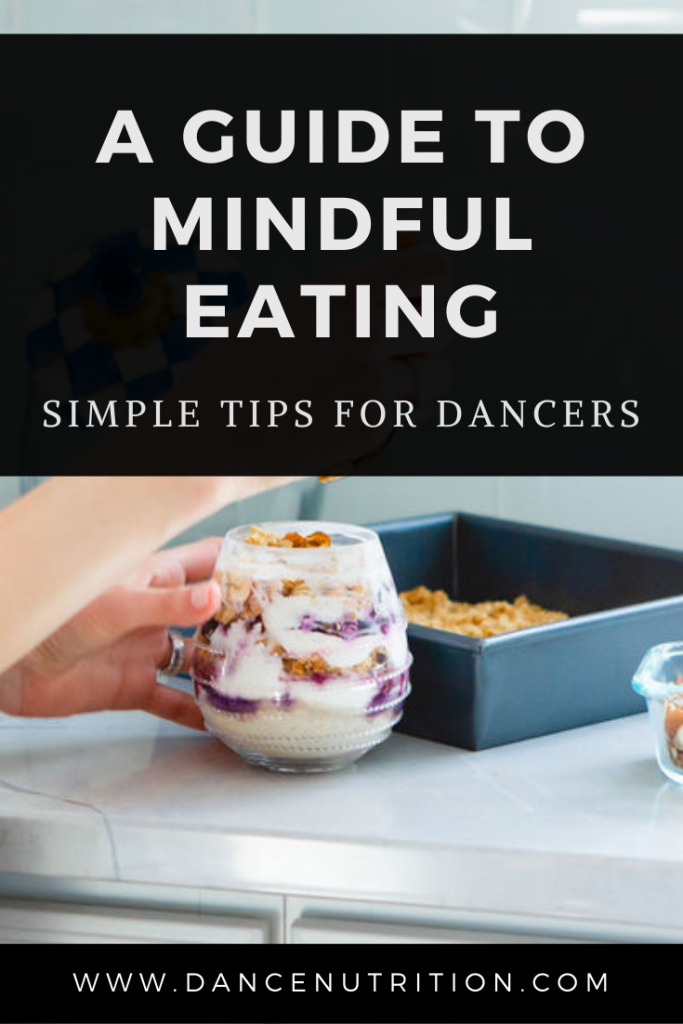Diet culture has hijacked the idea of mindfulness. In regards to food, we 0ften see mindful eating depicted alongside “The Hunger/Fullness Diet,” which repackages Intuitive Eating into a set of restrictive rules that hyper-focus on what we’re eating, when we’re eating, and how much we’re eating. In fact, I’ve previously discussed red flags of the anti-diet space, and this is a huge example of it. Common iterations of mindful eating involve a preoccupation with food.
Don’t get me wrong— tuning into hunger and fullness is a HUGE part of intuitive eating. But many dancers struggle to rely fully on their intrinsic cues and for this reason, intuitive eating isn’t always the ultimate goal. This is usually a result of either intentional restrictions (like dieting) or unintentional restrictions. If you’re wondering where your cues have gone, then check out this article.
Here’s what mindful eating is NOT
Mindful eating is not explicitly designed to help one heal from diet culture nor is it a swap for intuitive eating. As a reminder, intuitive eating is an entire paradigm designed to help people heal from diet culture and disordered eating. You can learn more about intuition, and the 10 specific principles it involves, here.
Mindful eating is also not an end goal of intuitive eating. Mindful eating is just a tool that can help in the process of rebuilding your relationship with food.
What is mindful eating?
Mindfulness involves an increase in awareness of something specific and in regard to eating, this awareness is towards food. When the time is right, mindfulness enables you to connect to the present moment. As you do this, you’ll process the information more clearly and be better equipped to make decisions that serve you at that moment.
When you begin to utilize mindful eating techniques, you add a major “nutrient” back to your balanced plate: satisfaction. Your mindful experience, whether it is positive, negative, or neutral, blooms a unique learning opportunity that allows you to move forward with building trust in your body’s intrinsic cues of hunger, fullness, and satisfaction. Overall, you’ll begin to experience fewer instances of feeling “out of control” around food and even less guilt around food.
Should dancers always aim for mindful eating experiences?
If we strive for mindful mealtimes 100% of the time, we risk turning the process of mindful eating into a restrictive food rule. The expectation to eat mindfully 100% of the time doesn’t take life (and its many curve balls) into account. In fact, many dancers cannot utilize mindful eating techniques until later in their journey of healing from diet culture. This is because, to truly harness mindfulness at mealtimes, a proactive effort is first needed to alleviate any potential mealtime anxiety— not seeing foods as “good” and “bad,” overcoming fears of weight gain and relinquishing the supposed need to micromanage your food choices, to name only a few.
Also, experiences of “emotional” eating, binge eating, and “over”-eating— those often intervened upon with tools like mindful eating— should never imply shame. Each of these experiences might be a survival mechanism designed by your body in response to deprivation. Read more about it here and here. In these instances, before mindful eating techniques are utilized, working with a Registered Dietitian Nutritionist is encouraged to intervene upon the point of deprivation.
How can mindful eating benefit dancers? 10 tips for dancers to eat mindfully
Here are 10 tips for eating mindfully. Before you dive in, grab a journal (or, for the dancers who work with me, grab a copy of your Food & Mood Journal from The Healthy Dancer®).
- Start eating enough throughout your day. Whether intentional or unintentional, under-fueling makes it IMPOSSIBLE to enter a meal or snack mindfully. To learn more about the signs of under-fueling and learn how to fuel adequately, read this article.
- Then, pick 1 meal or snack each day (more if you have the time) and set time aside for the experience that we’re about to walk through.
- Tap into your senses: what’s the aroma like? How does the plate or food look to you? How about the texture? Does it look appetizing?
- Take an external scan: what’s your environment like? Are you with pleasant company? Do you feel the tension in the air? Are you sitting in a busy and/or loud room (like a cafeteria)? These scenarios could impact how you eat (fast, slow, tense, calm).
- Now take an internal scan: are you feeling stressed or anxious? If so, try a deep breath. Are you feeling relaxed or extra sociable? How might this impact your ability to tune into those sensations explored in Step 3?
- As you begin to eat, dive deeper into the flavors. Are they familiar? New? Straight forward or complex? More seasoned foods will have more complex flavors.
- Now the texture. Soft? Crunchy? Chewy? Anything, in particular, you like or dislike?
- Assess three times. Are your fullness cues starting to emerge? Assess this at three different points throughout your meal or snack: (1) when you’re about 25% in, (2) at the 50% mark, and (3) if and when you’ve eaten about 75% of the food. Utilize The Hunger Fullness scale to identify what that means for you.
- Remove any judgment that seeped in. You have permission to eat your entire meal (or snack). Forget about serving sizes and instead, discover portion control from within. Here’s an article to help with this.
- Give yourself 5 and 20. First, ✋hi-5! From long rehearsal days and never-ending screen time, gifting yourself the time to practice mindful eating is not easy. Now that you’ve done it, consider waiting about 20 minutes before assessing final fullness and satisfaction.
Mindful eating for dancers: self-evaluation
Now that you’ve walked through the process, jot down how you feel and if any changes might help in the future. Still hungry or not feeling satisfied? Assess whether your meal or snack was balanced. Also, you’ll need to make sure you’re honoring food preferences (rather than food rules). Here are two additional articles to help you discover opportunities for change.
You can also assess whether mindful eating left you feeling satisfied, or, perhaps left you feeling scrutinized and deprived. If the latter is true, consider if your goal for mindful mealtimes is both extreme and impractical at this moment. Mindless eating is a form of emotional eating and spoiler: doesn’t have to be something to hide about.
Mindful eating for dancers: key takeaways
If we’re stressing over the idea of eating mindfully, then we’re probably not fostering a supportive experience at mealtimes. Instead, allow mindful eating to help you create an experience.
And before you ridicule yourself for “not eating mindfully,” remember that mindless eating is a very normal and valid experience. It’s also likely your body is responding to some type of restriction. Either way, don’t strive to eat mindfully 100% of the time. You’re busy! There will be times when mindful eating is impractical. When you can, set time aside and work through the exercises above!




